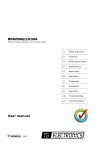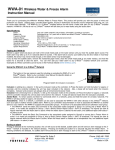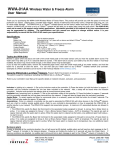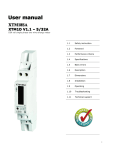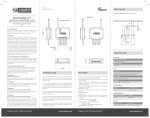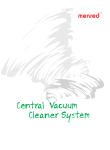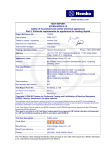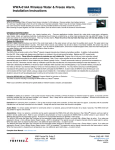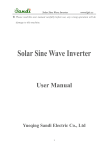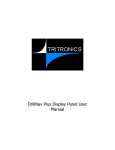Download TZ06 In Wall Dual relay(1 way) switch module P Adding
Transcript
TZ06 In Wall Dual relay(1 way) switch module kind of light like incandescent, fluorescent and LED light. This module can also connect to alternative power supply like DC 12V to switch on/off 12V MR-16 light as follow picture. Adding to Z-WaveTM Network In the front casing, there is an on/off button with LED indicator below which is used to toggle switch on and off or carries out inclusion, exclusion, reset or association. When first power is applied, its LED flashes on and off alternately and repeatedly at 2-second intervals. It implies that it has not been assigned a node ID and cannot work with Z-Wave enabled devices. P Auto Inclusion The function of auto inclusion will be executed as long as the in wall switch does not have Node ID and just connect the switch to main power. Note: Auto inclusion timeout is 4 minute during which the node information of explorer frame will be emitted once every 5 seconds. Unlike “inclusion” function as shown in the table below, the execution of auto inclusion is free from pressing the On/Off button on the Switch. The table below lists an operation summary of basic Z-Wave functions. Please refer to the instructions for your Z-WaveTM Certificated Primary Controller to access the Setup function, and to include/exclude/associate devices Function No node ID Fig 1. Assembling Inclusion This in-wall switch module is a transceiver which is a Z-WaveTM enabled device and is fully compatible with any Z-WaveTM enabled network. Mini size design let the module can easily hide itself into the wall box and that will be good for the house decoration. There are many kind of application by using the module to switch Load On and Off , one main application Exclusion is the light control. If connect the com port directly to AC Line terminal ,the new smart relay calibration technology can reduce the inrush current caused by the load and let the module work perfectly with many 1 Description The Z-Wave Controller does not allocate a node ID to the Switch. 1. Have Z-Wave Controller entered inclusion mode. 2. Pressing Include button of TZ06 three times within 1.5 seconds will enter inclusion mode. 1. Have Z-Wave Controller entered exclusion mode. LED Indication 2-second on, 2-second off One press one flash One press one flash 2. Reset 1. 2. 3. Association 1. the LED will flash on and off alternately at 2-second intervals. Pressing Include button of TZ06 three times within 1.5 seconds will enter exclusion mode. Node ID has been excluded. 2-second on, 2-second off Pressing Include button of TZ06 three times within 1.5 seconds will enter inclusion mode. Within 1 second, press Include button of TZ06 again for 5 seconds until LED is off. IDs are excluded. One press one flash Have Z-Wave Controller entered association mode. Or Pressing Include button of TZ06 three times within 1.5 seconds will enter association mode 2. There are 3 groups for the switch Choosing a Suitable Location 2-second on, 2-second off 1. Do not locate the Switch facing direct sunlight, humid or dusty place. 2. The suitable ambient temperature for the Switch is 0°C~40°C. 3. Do not locate the Switch where exists combustible substances or any source of heat, e.g. fires, radiators, boiler etc. 4. After putting it into use, the body of Switch will become a little bit hot of which phenomenon is normal. One press one flash Installation Including a node ID allocated by Z-Wave Controller means inclusion. Excluding a node ID allocated by Z-Wave Controller means exclusion. Failed or success in including/excluding the node ID can be viewed from the Z-Wave Controller. Sometimes people are not easy to execute exclusion or inclusion especially when TZ06 already installed in a wall box. To solve this issue, TZ06 support a special feature that can use S1 or S2 to execute “exclusion, inclusion, Reset or Association” at the first 3 minutes when first time connect to main power. LED Indication To distinguish what mode the switch is in, view from the LED for identification. State Type Normal No node ID 1. Put the in wall switch into a wall box and connect the AC power wire L,N to TZ06 connector L, N. 2. Connect the wall switch to the TZ06 as Fig1 . 3. There are 3 mode TZ06 can be configured to match different kind of wall switch, please refer to 3-2 Edge / Pulse / Edge-Toggle mode which described in next section of this user manual 4. If Edge-Toggle mode has been set, and the S1 S2 is connect to normal bi-stable switch, every time when change the state of the wall switch will also swap the state of Relay1 or Relay2 LED Indication Whenever we switch On and off of the TZ06 by S1 S2 or On/Off button or RF command , the LED will lights up 1 second and then off. Under normal operation, when the Switch has not been allocated a node ID, the LED flashes on and off alternately at 2-second intervals. By pressing S1 S2 or On/Off button, it will stop flashing temporarily. However, after disconnect and reconnect the Switch, 2 Programming Configuration parameter 1=3 switch ON and OFF of relay 2 1. Basic Command Class / Binary Switch Command Class The Switch will respond to BASIC and BINARY commands that are part of the Z-Wave system. , [Command Class Basic, Basic Set, Value = (255)0xFF]: the load attached to the Switch turns on. [Command Class Basic, Basic Set, Value = 0(0x00)]: the load attached to the Switch turns off. [Command Class Switch Binary, Switch Binary Set, Value = (255)0xFF]: the load attached to the Switch turns on. [Command Class Switch Binary, Switch Binary Set, Value = 0(0x00)]: the load attached to the Switch turns off. 1-1 BASIC_GET / BINARY_SWITCH_GET Since the switch have two relay, the Switch will report its On/Off state to the Controller by setting Configuration parameter 1. Configuration parameter 1=1(default) Report ON either relay 1 ON or relay 2 ON Report OFF when both relay 1 and relay 2 OFF Configuration parameter 1=2 Report ON when relay 1 ON Report OFF when relay 1 OFF Configuration parameter 1=3 Report ON when relay 2 ON Report OFF when relay 2 OFF 2. Z-Wave’s Groups (Association Command Class Version 1) The Switch can be set to send reports to control associated Z-Wave devices. It supports 3 association groups which every group has one node support. Group1~Group3 support SWITCH_BINARY_REPORT. Basic Get Command: [Command Class Basic, Basic Get] Basic Report Command: Report OFF: [Command Class Basic, Basic Report, Value = 0(0x00)] Report ON:[Command Class Basic, Basic Report, Value = (255)0xFF] For group 1, the Switch will report ON/OFF status of Relay1 and Relay2 For group 2, the Switch will report ON/OFF status of Relay1 For group 3, the Switch will report ON/OFF status of Relay2 2-1 Auto report to Grouping 1 ~3(Maximum Node 1) Binary Switch Get Command:[Command Class Switch Binary, Switch Binary Get] Binary Switch Report Command: Report OFF:[Command Class Switch Binary, Switch Binary Report, Value =0(0x00)] Report ON:[Command Class Switch Binary, Switch Binary Report, Value = (255)0xFF] 2-1-1 On/Off Event Report When “on” or “off ” state has been changed (ex. Press S1 S2 or include on/off button), it will send Binary Switch Report to the nodes of Group1~3. Binary Switch Report ON:[Command Class Switch Binary, Switch Binary Report, Value =(255)0xFF] OFF:[Command Class Switch Binary, Switch Binary Report, Value =0(0x00)] 1-2 BASIC_SET / SWITCH_BINARY_SET Since the switch have two relay, the load attached to the Switch will turn on or off upon receipt of the following commands from a Z-Wave Controller by setting Configuration parameter 1. Configuration parameter 1=1(default) switch ON and OFF both relay 1 and relay 2 Configuration parameter 1=2 switch ON and OFF of relay 1 2-2 Multi Channel Command Class Version 3 3 TZ06 also support muti channel command class(version 3) , which include COMMAND_CLASS_MULTI_CHANNEL BINARY_SWITCH_GET, BINARY_SWITCH_SET MULTI_CHANNEL_CMD_ENCAP You may control or get report from 3 endpoint of TZ06 2-2-1 BINARY_SWITCH_GET, Source End Point = 0x01 Since the endpoint is 1 so TZ06 will reply ON(0xFF) either Relay 1 or Relay2 You may get the ON/OFF state from every endpoint, when endpoint set to 1 , TZ06 will reply ON(0xFF) either Relay 1 or Relay2 is ON, report OFF (0x00) when is ON, report OFF (0x00) when both both Relay 1 and Relay2 OFF . If endpoint set to 2 , TZ06 will reply state of Relay 1 and Relay2 OFF Relay1 . If endpoint set to 3 and TZ06 will reply state of Relay2 (Bit Address+Destination End Point = 0x05) (Bit Address =0;Destination End Point) Below is a example show a source endpoint 5 send a get command to TZ06 endpoint 1 Command Class = 0x25 (Command_Class_Switch_Binary = 0x25) COMMAND_CLASS_MULTI_CHANNEL Command =0x03 MULTI_CHANNEL_CMD_ENCAP Parameter 1 = 0xFF Source End Point = 0x05 (this is the endpoint of command owner (Switch_Binary_Report = 0x03) (ON=0xFF , OFF=0x00) 2-2-2 BINARY_SWITCH_SET here we assume endpoint is 5,if the By using BINARY_SWITCH_SET Command of Multi Channel Command Class owner doesn’t support multi Encapsulation Command, you can switch both Relay1 and Relay2 ON/OFF by Channel this value will be 0) setting endpoint to 1 or switch Relay1 ON/OFF by setting endpoint to 2 or switch (Bit Address+Destination End Point = 0x01) (Bit Address =0;Destination End Point Relay2 ON/OFF by setting endpoint to 3 range from 1~3) Command Class = 0x25 (Command_Class_Switch_Binary = The example of the command show that switch off relay1 of TZ06 0x25) COMMAND_CLASS_MULTI_CHANNEL Command =0x02 (Switch_Binary_Get = 0x02) MULTI_CHANNEL_CMD_ENCAP Source End Point = 0x01 Below is the example show TZ06 report to last command 4 (this is the endpoint of command owner or Binary Switch Command Class. here we assume endpoint is 1,if the 3-1-1 Selected Endpoint 1: Default Selected Endpoint is 1 owner doesn’t support multi Channel this value will be 0) (Bit Address+Destination End Point = 0x02) (Bit Address =0;Destination End Point Set command Relay state Basic Set or Binary_Switch_Set ON Relay1 ON Relay2 ON Relay1 OFF Relay2 OFF range1~3) Basic Set or Binary_Switch_Set OFF Command Class = 0x25 (Command_Class_Switch_Binary = & & 0x25) Command =0x01 (Switch_Binary_Set = 0x01) Get command Relay state Basic_Get or Binary_Switch_Get Relay1 ON or ON Relay2 ON Relay1 OFF & OFF Relay2 OFF Basic_Get or Binary_Switch_Get (ON=0xFF , OFF=0x00) Parameter 1 = 0x00 Report to command sender 3-1-2 Selected Endpoint 2 Similar like Selected Endpoint 1 but only relate to Relay1 and ignore Relay2 3. Z-Wave’s Configuration Configuration Parameter 1 2 Function Slected End Point Edge or Pulse mode or Edge-Tog gle mode Size (Byte) 1 1 Value 1-3 1-3 Unit Default Description 1 1:Relay1 & Relay2 2:Relay1 3:Relay2 1 3-1-3 Selected Endpoint 3 Similar like Selected Endpoint 1 but only relate to Relay2 and ignore Relay1 3-2 Edge / Pulse / Edge-Toggle mode Manual switch S1 and S2 can set to Edge mode or Pulse mode or Edge-Toggle mode , default value is Edge mode. 1:Edge mode Edge mode: this mode is suitable for the bi stable wall switch that has indicator point 2:Pulse mode on the switch, and the same position correspond to same state of relay1 and relay2 . 3:Edge-Toggle mode if the TZ06 relay change the state because of receiving Z-Wave RF command, it may need two times of change (switch on to off or switch off to on) to let relay back to the correspond state. 3-1 Selected Endpoint If Controller not using Multi_Channel command class to access the endpoint of TZ06, you may configure the endpoint value to react the Basic Command Class 5 Specification Pulse mode: this mode is suitable for the toggle type wall switch to swap the state of Relay1 or Relay2 Operating Voltage 100 ~240VAC 24-60V DC ±10% Maximum Load Range Operating Temperature Frequency Range 1500W X2 (220V) 800W X 2 (120V) Edge-Toggle mode: this mode is suitable for the normal bi-stable switch, every time when change the state of the wall switch will also swap the state of Relay1 or Relay2 4. Command Classes ** Specifications are subject to change and improvement without notice. The Switch supports Command Classes including… * COMMAND_CLASS_SWITCH_BINARY * COMMAND_CLASS_BASIC * COMMAND_CLASS_MANUFACTURER_SPECIFIC_V2 * COMMAND_CLASS_VERSION * COMMAND_CLASS_SWITCH_ALL * COMMAND_CLASS_ASSOCIATION_V1 * COMMAND_CLASS_CONFIGURATION * COMMAND_CLASS_MULTI_CHANNEL_V3 * COMMAND_CLASS_ALARM Warning: 1.Plug out to disconnect from power supply; Do not plug in line. 2. Do not exceed the max rating Disposal Troubleshooting Symptom Cause of Failure The Switch not working and 1. The Switch is not LED off connect to the Main power 2. The Switch break down The Switch LED Check if the load connect illuminating, but cannot into the Switch has its control the ON/OFF own ON/OFF switch Switch of the load attached The Switch LED 1. Not carry out illuminating, but the association Detector cannot control 2. Same frequency the Switch interference LED keep flashing Overload occurs continuously, but cannot control Minimum 30 m in door 100m outdoor line of sight 0°C ~ 40°C TZ06 868.42 (EU) / TZ06 908.42(USA/Canada) / TZ06 922.5/923.9/926.3MHz (Taiwan/JP)MHz This marking indicates that this product should not be disposed with other household wastes throughout the EU. To prevent possible harm to the environment or human health from uncontrolled waste disposal, recycle it responsibly to promote the sustainable reuse of material resources. To return your used device, please use the return and collection systems or contact the retailer where the product was purchased. They can take this product for environmental safe recycling. Recommendation 1. Check power connections 2. Don’t open up the Switch and send it for repair. Set the ON/OFF switch of the load attached to ON Company of License Holder:TKB Control System Limited 1. Carry out association 2. Wait for a while to re-try Address of License Holder:No. 8 Xiqiao Road, Liushi, Yueqing City, Zhejiang Province, 325604, China Remove the load attached or check max. load cannot exceed 1500W~1650W 6 This transmitter must not be co-located or operating in conjunction FCC Interference Statement with any other antenna or transmitter. This equipment has been tested and found to comply with the limits for a Class B digital device, pursuant to Part 15 of the FCC Rules. These limits are designed to provide reasonable protection against harmful interference in a residential installation. This equipment generates, uses and can radiate radio frequency energy and, if not installed and used in accordance with the instructions, may cause harmful interference to radio communications. However, there is no guarantee that interference will not occur in a particular installation. If this equipment does cause harmful interference to radio or television reception, which can be determined by turning the equipment off and on, the user is encouraged to try to correct the interference by one of the following measures: • Reorient or relocate the receiving antenna. • Increase the separation between the equipment and receiver. • Connect the equipment into an outlet on a circuit different from that to which the receiver is connected. • Consult the dealer or an experienced radio/TV technician for help. This device complies with Part 15 of the FCC Rules. Operation is subject to the following two conditions: (1) This device may not cause harmful interference, and (2) This device must accept any interference received, including interference that may cause undesired operation. FCC Caution: Any changes or modifications not expressly approved by the party responsible for compliance could void the user's authority to operate this equipment. 7







